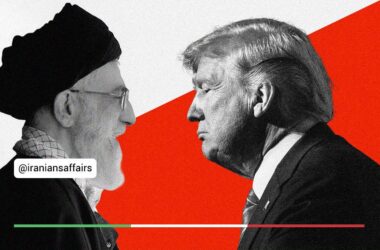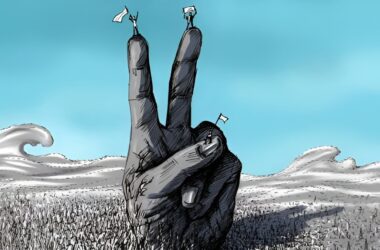The irreparable and fundamentalist structure of the Islamic Republic will prevent any peaceful change. Therefore, the model for change for nationalists will be non-pacifist, though non-violent.
The national opposition is more concerned about Iran and its territorial future than any other group and seeks to remove obstacles through the least costly method of change to return to the path of Iranian nationalism. For this reason, emphasizing a national revolution and centralized leadership minimizes undesirable possibilities and creates the conditions for establishing a national government.
Due to its complex political, social, and security structure, the Islamic Republic is considered one of the most difficult countries to implement governmental changes in. In recent decades, widespread protests and internal efforts have not been able to challenge the regime, and economic sanctions have not led to the collapse of the security institutions’ power. In such circumstances, the need for national leadership and the execution of a coordinated regional and international plan for change in Iran is felt more than ever. Reza Pahlavi, as a national and democratic figure who emphasizes the preservation of Iran’s territorial integrity, can play a central role in this process.
In this article, we examine the different types of foreign interventions, the conditions and tools necessary for their implementation, as well as the role of Reza Pahlavi and the proposed Cyrus Accord as a regional framework for supporting a future democratic Iran.
1. The Importance of National Leadership and the Role of Reza Pahlavi in Maintaining Unity and Territorial Integrity
A. Why is national leadership crucial in political changes?
“Our issue is national, and it requires a national solution. The society is strongly nationalist. Iranian nationalism is liberal and civic. This nationalism has evolved and organized based on the issue of Iran, beyond mere patriotism. It is a response to a clear vision of the future and the issue of development. It encompasses both those seeking change and the reasons for that change.” {Majid Tavakoli}
Research and studies on the factors influencing social movements and revolutions show that the presence of national leadership and efforts to create meaningful organization in the course of changes can significantly increase the chances of success. In most cases, the presence of a strong nationalist leader has helped garner the trust of various groups, preventing chaos, disorder, and civil war. National leadership can:
1- Plan for the transition period and prevent a power vacuum.
2- Guide various internal groups and prevent internal divisions and competition.
3- Convey a unified message to the international community, leading to global consensus in support of the changes.
B. The Role of Reza Pahlavi in This Framework
Reza Pahlavi, as a well-known figure in the Iranian opposition, possesses the necessary qualities to fulfill the role of national leadership:
1- National legitimacy: As the son of Iran’s last shah, he symbolizes for many Iranians a connection to Iran’s history, traditions, and national values.
2- Inclusive discourse: Reza Pahlavi emphasizes a peaceful transition, non-revenge, and the preservation of territorial integrity, distinguishing him from other opposition leaders.
3- Prevention of disintegration and collapse: In a situation where various groups may seek their own interests after the regime’s collapse, Reza Pahlavi can act as a stabilizing force, ensuring national unity.
C. Emphasis on Preserving Territorial Integrity and Preventing Disintegration
One of the greatest risks following any governmental change in Iran is the potential for separatism and the emergence of ethnic and religious divisions. Reza Pahlavi, with his nationalist rhetoric and emphasis on a shared Iranian identity, has worked to alleviate these concerns. He has explicitly stated that the transition to democracy must occur without harming Iran’s territorial integrity, and that any disintegration or collapse would only benefit foreign enemies.
2. Types of Foreign Interventions: Tools and Various Scenarios
Foreign interventions can occur at different levels and with various objectives. From intelligence and security interventions to limited military strikes and the application of political and economic pressures, all these tools can be used to weaken the regime and strengthen internal forces. Below is a detailed analysis of each of these scenarios and the conditions necessary for their implementation.
A. Intelligence and Security Interventions: The Cornerstone of Change in Iran
1- Providing Strategic and Tactical Information:
– Currently, Iran’s military and security forces are well aware of their military inferiority compared to advanced countries. They know that Iran’s air, naval, and ground forces are highly limited in facing foreign forces.
– Providing precise information about the weaknesses within the IRGC’s structure, command centers, and financial and logistical networks can help internal forces neutralize suppression plans and better coordinate large-scale protests.
2- Cyber Attacks and Intelligence Operations:
– Cyberattacks on the regime’s communication and financial networks can severely weaken the regime’s ability to suppress widespread protests. For example:
– Disrupting the regime’s financial and banking systems can reduce their financial resources for carrying out suppression operations.
– Attacks on the IRGC’s communication networks and the release of sensitive information can cause confusion within the command structure.
3- Supporting Covert Intelligence and Media Networks:
– Creating and strengthening covert intelligence networks inside the country to gather information and expose corruption among regime leaders can help weaken the regime’s credibility.
– Supporting free and underground media to broadcast opposition messages and mobilize the public is essential.
B. Limited Military Intervention: Shifting the Balance of Power on the Ground
In the late 20th and early 21st centuries, various revolutions occurred in Eastern Europe, where NATO and the U.S.’s controlled and limited intervention against the Milosevic regime in Yugoslavia played a significant role in halting military support for the established government. In this case, after a period of limited attrition warfare and weakening Yugoslavia’s economic foundations, a comprehensive youth movement arose against the regime, and a guarantee was needed to ensure the military would not side with the government. Limited military intervention, in addition to targeting barracks and issuing serious warnings to the military to avoid using weapons against civilians, allowed the opposition to achieve ultimate victory by targeting the presidential palace.
In certain circumstances, and despite differences in the political and social structure of Iran and Yugoslavia, limited military intervention can be used to stop the military from suppressing the people, and with the presence of a national opposition, direct targeted blows can lead to specific results.
Widespread military intervention may lead to instability and civil war, but limited and targeted strikes can significantly weaken the regime without causing chaos:
1- Airstrikes on Critical Sites:
– Targeting the regime’s command centers, arms depots, and missile facilities can reduce their military capabilities to confront large-scale protests. The Serbian example stands as a successful model, distinct from Afghanistan and Iraq.
2- Establishing Safe Zones:
– Establishing a no-fly zone in areas where widespread protests are emerging can prevent the regime’s air force from being used for suppression, as seen in Libya and Iraq in 1991.
3- Support for Dissatisfied Internal Forces:
– Within the military, especially the air force and ground forces, some officers and commanders are disillusioned by outdated equipment and lack of access to modern technology. They may readily join the opposition.
– Providing advanced defensive and communication equipment to these forces can protect them from regime threats and lay the groundwork for weakening the regime’s military structure.
C. Creating a Regional Coalition: The Cyrus Accord and Israel’s Role
One of the key strategies for successful intervention in Iran is the creation of a regional coalition that can support a democratic and stable Iran. In this regard, the Cyrus Accord, proposed by Reza Pahlavi, could play a central role.
1- The Cyrus Accord: A Regional Alliance for Peace and Stability:
– The Cyrus Accord, as proposed by Reza Pahlavi, could serve as a framework for cooperation between a future Iran and regional countries.
– This accord could emphasize security, economic, and political cooperation among regional countries, especially Israel, Egypt, Saudi Arabia, and the UAE.
– The primary goal of this accord is to establish a regional structure to counter shared security threats and support a democratic Iran.
2- Israel’s Role as a Strategic Partner:
– Given the security threats posed by the current Iranian regime, Israel could act as one of the main supporters of changes in Iran.
– Israel’s intelligence and security cooperation with the Iranian opposition, through the provision of precise information, cyber operations, and even limited military support, could strengthen the opposition.
– Strategic collaboration between Israel and the Iranian opposition can bolster the opposition’s security and intelligence infrastructure. Israel, with its advanced capabilities in intelligence and cyber operations, can assist the opposition in disrupting the regime’s oppressive networks and weakening the Islamic Republic’s command and control systems.
– Operational Collaboration in Supporting Internal Forces: In the event of widespread protests and large-scale civil disobedience, Israel could help coordinate military efforts and provide limited military equipment to dissatisfied internal forces, boosting their ability to resist suppression.
3- The Role of Arab Countries and Completing the Cyrus Accord:
– Arab countries like Saudi Arabia, the UAE, and Bahrain can strengthen the opposition through financial, diplomatic, and even military support.
– Cooperation between future Iran and the Gulf states within the framework of the Cyrus Accord could lead to the formation of a new security coalition in the Middle East, neutralizing the current threats posed by Iran and contributing to long-term regional stability.
– In addition to the Abraham Accords, which normalized relations between Israel and some Arab countries, the Cyrus Accord could play a complementary role, expanding the axis of regional cooperation to include a future democratic Iran.
D. The Role of the United States in Supporting the Opposition
In the United States, the Republican Party has taken a more aggressive stance toward the Islamic Republic, while the Democrats need to adjust their policies and reassess some of the optimism and propaganda within the party. Since the Trump administration’s withdrawal from the nuclear deal (JCPOA), Republicans have pursued a maximum pressure strategy against the Iranian regime. In the current context, bipartisan support for initiatives like the Cyrus Accord could be effective in several areas:
1- Political and Diplomatic Support for Reza Pahlavi’s National Leadership:
– Recognizing Reza Pahlavi as the legitimate representative of the Iranian opposition by the United States could increase his international legitimacy.
– In the event of a Republican administration, there will likely be more focus on supporting democratic forces and strengthening the opposition in Iran.
2- Intensifying Economic Pressure and Targeted Sanctions:
– U.S. Republicans are pushing for stronger sanctions against key institutions of the Islamic Republic, particularly the IRGC. These sanctions can limit the regime’s financial resources for suppressing the people and weaken the power structure.
– Providing financial and logistical assistance to opposition organizations operating outside Iran could empower the opposition to manage protests and lead popular movements.
3- Building International Consensus Against the Islamic Republic:
– The U.S. can use its influence in international forums like the UN Security Council and the European Union to build global consensus against the Islamic Republic and support the opposition led by Reza Pahlavi.
– Leveraging strong relationships with regional countries, like Israel and Saudi Arabia, the U.S. can form a regional coalition to counter Iran’s influence and establish the groundwork for cooperation following the regime’s collapse.
3. The Cyrus Accord: A Regional Framework for Supporting a Democratic Iran
“Through this partnership, through this coordinated action, we can achieve freedom for the people of Iran, security for Israel, the United States, and the Arab world, and a real opportunity for a bright future for the Palestinians. If we do not act, and the Islamic Republic remains in power, none of this will be possible. But if we work together, we can guarantee prosperity and dignity for our people, and stability and security for our world, expanding from the Abraham Accords to the Cyrus Accord.” — Prince Reza Pahlavi
The Cyrus Accord, as proposed by Reza Pahlavi in his recent speeches, is recognized as a regional initiative to bring stability and peace to the Middle East. Modeled after the Abraham Accords, this agreement seeks to create a regional and international partnership that builds a security and economic framework to support a democratic and unified Iran.
A. Goals and Content of the Cyrus Accord
1- Creating a Regional Coalition for Stability:
– The Cyrus Accord emphasizes regional support for a democratic Iran and collective security cooperation. Member countries of this accord will commit to working together to counter common threats, including terrorist groups and destabilizing elements in the region.
– The accord also stresses the importance of maintaining Iran’s territorial integrity and preventing any potential separatism, while striving to avoid internal conflicts that could turn Iran into a battleground.
2- Security and Intelligence Cooperation:
– Member countries, including Israel, Saudi Arabia, the UAE, and Egypt, can cooperate on intelligence and security matters to support internal Iranian forces and counter the threats posed by the Islamic Republic regime.
– Intelligence sharing among member states, particularly in identifying terrorist networks, military installations of the regime, and financial resources of the IRGC, could significantly reduce the regime’s ability to suppress domestic opposition.
3- Economic Support and Post-Transition Reconstruction:
– A key goal of the Cyrus Accord is to provide economic support to Iran during its transition period and to rebuild the country’s damaged infrastructure.
– Regional countries, through participation in reconstruction and economic development projects, can help establish a sustainable economy in Iran and prevent the rise of extremist governments or militia groups during the transition.
B. Israel’s Key Role in the Cyrus Accord
1- Intelligence and Military Cooperation:
– As one of the most advanced countries in the region in terms of intelligence and security, Israel can serve as a central pillar in the Cyrus Accord by gathering intelligence, conducting cyber operations, and supporting domestic opposition forces in Iran.
– Establishing joint intelligence structures to exchange information and coordinate efforts against the Islamic Republic regime could severely limit the regime’s ability to counter domestic protests.
2- Israel’s Role in Building International Consensus:
– Leveraging its diplomatic ties in the United States and Europe, Israel can play a critical role in mobilizing international support for the formation of a global consensus against the Islamic Republic and in favor of Reza Pahlavi’s leadership.
C. Support from Arab Countries
1- Ensuring Regional Security and Preventing Threats:
– Arab countries, particularly Saudi Arabia and the UAE, can contribute to ensuring regional security by participating in the Cyrus Accord, helping to prevent tensions and conflicts following the collapse of the Islamic Republic regime.
2- Investment in Economic Reconstruction:
– Member states of the Cyrus Accord can engage in long-term investments in post-regime Iran and strengthen the local economy, thereby preventing the resurgence of extremist forces.
Given Iran’s complex structure and the key role that military and security forces play in maintaining power, any external intervention would require a comprehensive and multi-layered approach. The Cyrus Accord, centered around Reza Pahlavi, can serve as a framework for a regional and international coalition, setting the stage for a peaceful transition toward democracy. A strong regional coalition, backed by intelligence, military, and economic support for the opposition led by Reza Pahlavi, could lay the foundations for a free, stable, and united Iran.







